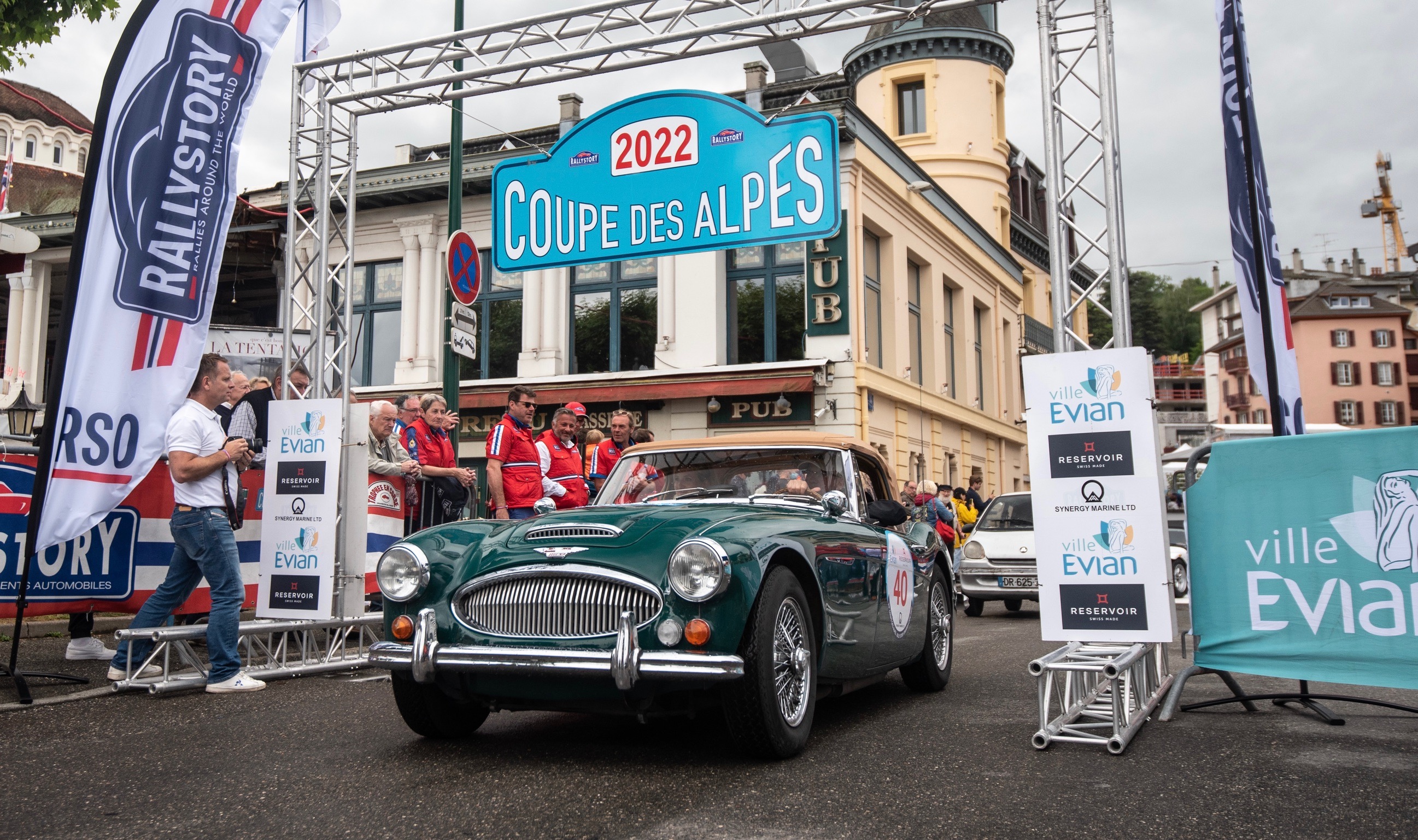
At a moment when, after many challenging years, my business crossed the line into sustainable positive cash flow, I rewarded myself with a vintage British sports car, an Austin Healey 3000 Mark III, that left the factory in 1967, one of the last ever made.
Growing up in Southern Ontario I had alternately lusted after American muscle and European finesse, but when I decided to recapture a lost youth, or more accurately one I had never had in the first place, the Healey checked all the boxes. And it wasn’t that expensive at the time, less than a new Honda Civic, although it has appreciated significantly since then.
I had spent some years in University in England, which tilted me towards their sports cars. The later Healey models were somewhat civilized, with features like wind-up windows, but still had the visceral connection to the road and engaged driving of a true roadster. And British tax law had given manufacturers the incentive to provide the pretence of back seats, taking advantage of a poorly thought-out definition of “family car”, so there was room in there for my young daughter and a friend…at least until they were about 10!
The Healey was notoriously rugged and reliable, less refined but also less finicky than the more beautiful Jaguar E-type that many of us had lusted after (and my business partner bought), but it still fell into the category of the car owned by the boys who got the girls when I was an impressionable teenager.
So, a ’67 Healey in British Racing Green on tan it was. The car’s original colour, with an interior that wasn’t offered at the time, but which was a classic combination on other vehicles of the era. I’ve owned the car for more than twenty years now, and it has given me and my family lots of pleasure, the odd drive to see the fall colours, errands, and trips to visit friends and family making up most of the two or three thousand miles a year we put on her.
Still, I knew the car had been built for more. Healeys were respected rally cars in the heyday of European rallying in the 50s and 60s, built to be driven hard and competitively for hours on end, in all road and weather conditions, and they were raced competitively as well.
There are opportunities for that in Canada, but somehow my work and family obligations had stopped me from attending Healey meets and other opportunities to drive the car as it was built to be driven. But when I learned that the famous Coupe des Alpes, the Alpine Rally trophy, won by famous drivers like Paddy Hopkirk, and Stirling Moss, had been revived for vintage car entries, I couldn’t get the idea of taking the Healey to Europe to drive the hairpin bend switchbacks of the high mountain passes out of my mind. This was the kind of event the Healey had been designed for.
Could I and my factory specification standard production Austin Healey possibly consider taking part?
To get a flavour of the history of this event, which runs through the mountains of France and Italy, you can find countless videos on Youtube. Watching them got my pulse racing, and I began to imagine what a memory it would be if my daughter and I could drive in it together, sharing the driving and navigating roles.
To be clear, I had taken a single competitive driving course at Shannonville more than 30 years ago. These rallies are gruelling tests of drivers and cars, and breakdowns are common. And I’m no mechanic. I am what is called in vintage car circles, with some disdain, a chequebook restorer.
Bob Yule at AutoFarm near Stratford, who specializes in Healeys, rebuilt my car’s engine and overdrive unit several years ago, strengthened the frame and refreshed the paint and interior. I can swap out plugs and points, replace a fan belt and maybe change a fuel pump if I had to but that’s pushing it.
So, what was I thinking contemplating participating in the Coupe des Alpes?
Unable to shake the idea, I contacted the organizers, Rallystory in France. They were quick to reassure me on all counts. The event is no longer competitive. There are no longer rally stages through the night, and there are breaks scheduled over the three days.
The route and passes to be covered will present really challenging driving, they assured me, but a mechanics team follows the rally to deal with participants in trouble.
It looked as if there were no excuses.
I booked time in my daughter’s schedule, arranged to ship the car by boat to Marseilles, ordered a set of critical spare parts from AutoFarm.
Following their advice, I had Kevlar brake pads fitted, tough enough to handle the repeated hard braking needed to manage the steep downhills of the rally.
That was in 2020. Then Covid intervened. I thought that would mean a year’s delay, which was OK because a Healey had won the rally in 1961, and Healeys would be honoured in 2021. That was not to be though, as in June 2021, the date of the event, getting the car to Halifax for shipment and ourselves to Europe was still just too complicated and fraught with risk. Rallystory let me roll my deposit over yet another year, and as Covid fears waned we started again to believe this dream project could come to fruition.
The car arrived in Halifax in plenty of time for the scheduled ship departure and we booked our flights. I tracked the ship online and saw that it might be a day or two late, but should still arrive, this time at Antwerp, in time for me to get the car through customs and to the rally start.
I called the shipper to make sure, only to learn the car had been bumped, apparently a common occurrence since Covid has disrupted shipping of all kinds.
So, with a little over two weeks to go, the car was sitting in the port of Halifax. My only option, other than to give up, walk away from the entry fee and our carefully made plans and preparation, was to scramble and see if we could get the car on air cargo.
After two years of Covid delays, I wasn’t about to be defeated this time.
Different paperwork including a dangerous goods certificate were needed, and putting all this together we missed one flight opportunity. Fortunately, I H Mathers Halifax office was able to secure space on the last possible flight out of Halifax, bound for Cologne, Germany.
I changed my flight to meet the car.
This was a bit of a learning experience for everyone, and it took three days to get German customs to release the car, with the help of German based AFL logistics. Bonus, I got to visit Cologne cathedral, and get over some of the jet lag.
The start of the rally was a fourteen-hour drive avoiding autoroutes, and I now had exactly two days to do it, on my own.
This turned out to be a blessing, as the weather was bad, and I got the chance at my own pace to get used to driving windy, narrow European roads, including some hills and mountains, getting a feel for the car under gentler conditions than what we would experience in the rally.
My daughter flew into Geneva, and we spent the night nearby, after packing what little we could fit into the limited storage space of the Healey (the so-called back seat folds down and becomes a parcel shelf, essential, as the trunk was full of spare parts and extra gas, the gauge in the car being somewhat unreliable and fuel economy variable on the mountain climbs and descents).
Then in the morning, we headed down to the rally start in the beautiful town of Evian-les-Bains, on the shores of Lake Geneva. We registered, collected our stick-on numbers and the road book, attached our Canadian flag, and joined the rest of the 150 entrants awaiting the start.
In spite of the rain, spectators crowded around the assembled collector cars. Among them were 50 Porsches, including a number of 356 models, the one made famous by James Dean’s fatal accident.
In 1965, the Coupe des Alpes was won by Paddy Hopkirk, in a Mini Cooper, and the original car was entered in this version, the 33rd running. The oldest car present was a 1954 Alfa Zagato
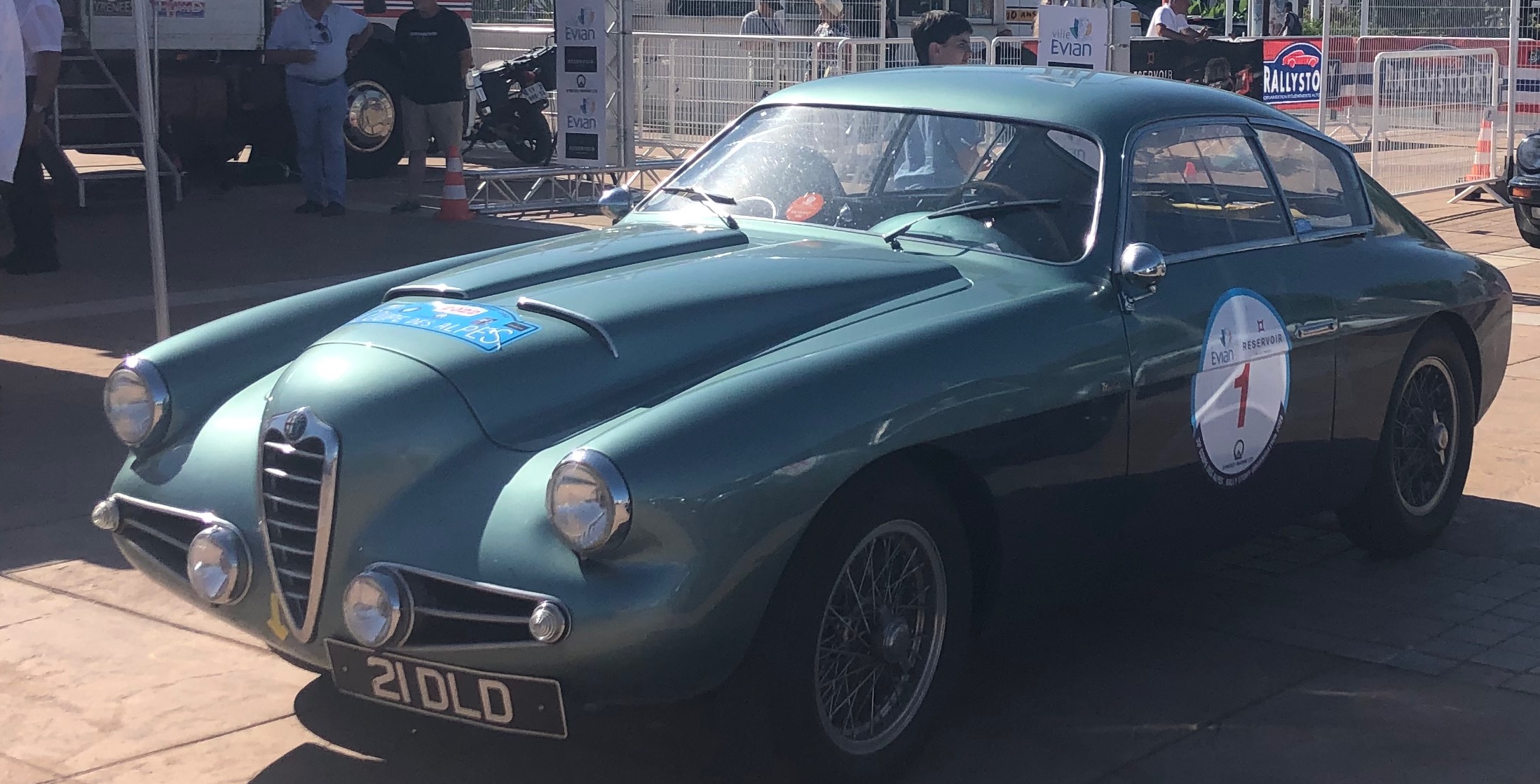
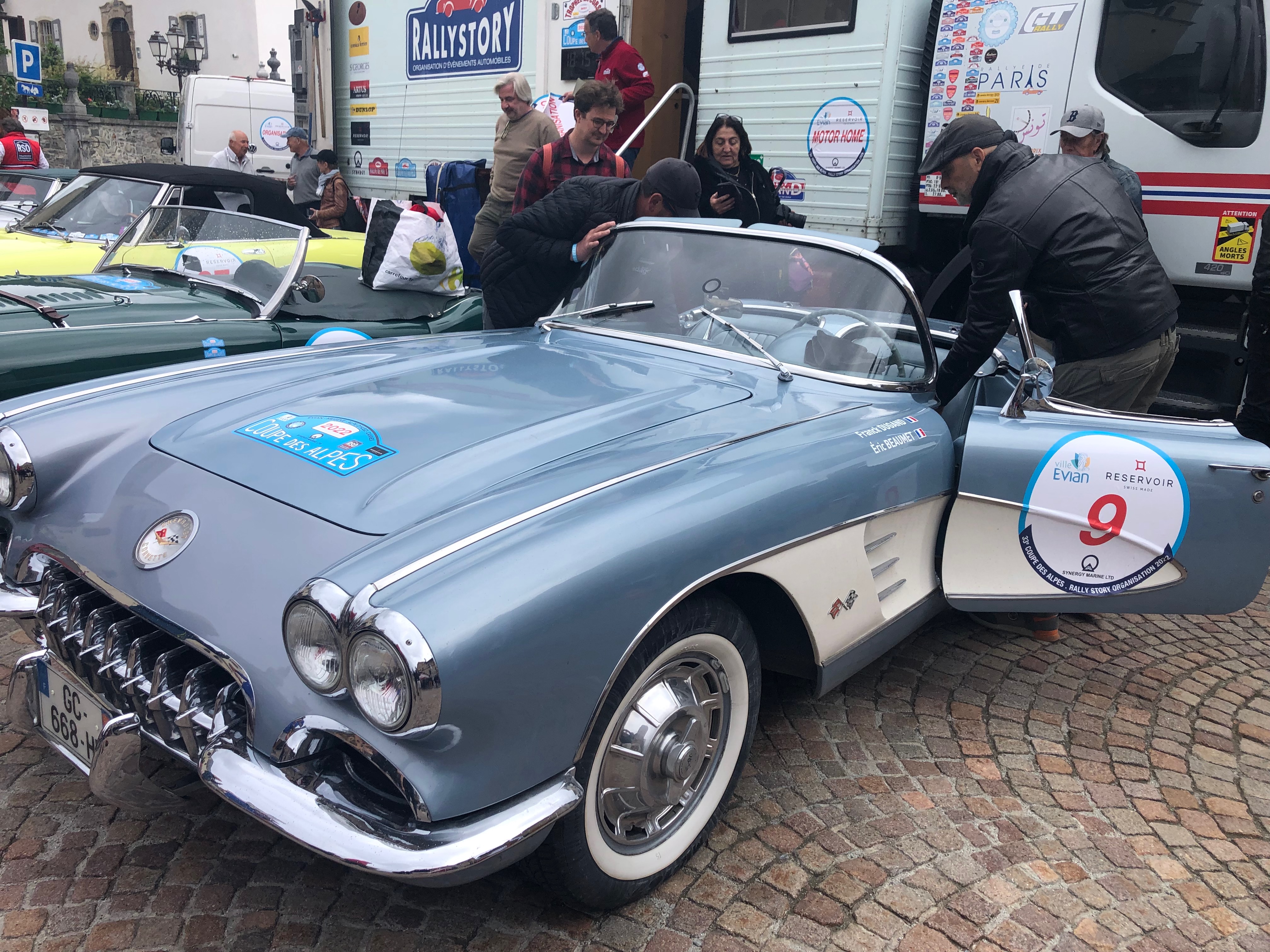
A 1960 Corvette, in magnificent condition, was a rare American-built entry, but the car proved poorly adapted to the driving ahead, the team exhausted at the end from hauling the heavy non-power steering V8 around the switchbacks.
A couple of Swiss-registered ’65 Mustangs and a ’65 and a ’70 Corvette brought the total Detroit iron contingent to 5 out of 150.
This really confirmed why we were here: European cars are designed for roads with lots and lots of turning, American cars for straight-line driving.
This would be a test for both of us, for while we have driven in Europe before, even in the mountains, the route ahead would be something else again. And neither of us had any experience pushing hard in a vintage standard shift car without power steering.
The rest of the field had a good selection of Minis, given a place of honour because of the victory in ’65, a number of E-type Jags, several Ferraris of different vintage, and numerous Alfa Romeos and Lancias. There was a BMW, a Peugeot, some Mercedes, a couple of Morgans and a Caterham 7, and a 1960 Volvo PV544 which had won the Ladies’ cup in 1962 and still bore its original start number from that race.
We pored over the road book, with its “tulips”, little diagrams telling you what to do at each point on the route, literally hundreds of decisions that mean the difference between reaching a checkpoint and finishing the rally.
And then, we set off.
Within a very short time we reached our first mountain pass, or “Col”, as the French call them. Altogether there were 16 of these, with a total of more than 24 kilometres of climbing, and the same of descents.
The first was the Col du Corbier, 1,237 m (4,058 ft). Roads were wet. This was our first exposure to our fellow participants’ driving.
The rally may not be competitive, in that everyone who finishes and hits all the checkpoints receives the same award, but just like wearing a bib turns a jogger into a runner, numbers on the sides of cars create a different feeling. Add that to cars designed to be driven hard and fast, along with (mostly) men who have perhaps not entirely grown-up (the present writer included), and you have the ingredients for excitement and many back-and-forth duels along the way.
Driving these mountain passes well takes a little getting used to.
It is rarely possible to know what a curve will look like before you are in it if you are doing it old school as we were without a GPS.
You don’t want to come in slow and realize it’s not as tight as expected, and you could have done it much faster. And you don’t want to come in so fast that you have to be on the brakes and don’t have proper steering control through the turn.
So, it’s a game of rapid anticipation and adjustment, where you come into a curve hard, downshift, most often on the passes into second gear, a gear you hardly use in normal driving, then step on the gas to help bring the no-power-steering car, in our case with a heavy 3-litre in-line 6, around what could be a 180 degree turn, a full hairpin switchback.
Sometimes you discover the turn is much less tight or the climb less steep than you expected and you move quickly up through the gears to push the car faster.
Other times you come in thinking you can stay in third, then looking around the corner and up the hill you realize the turn is very tight and the incline very steep, and you have to downshift, even double-clutch, hard and fast to have enough power to the rear wheels to get the car around, staying on your own side of the road.
.jpeg)
There are times when you do have enough visibility to plan your approach to a corner, or even to straighten the road by using both sides, but most of the time, you are reacting quickly to circumstances.
The Tour de France covers some of this route, and cyclists are training all over it.
Motorcyclists in full leathers from head to toe are also driving these roads with lots of enthusiasm.
The roads are not closed for the rally and you never have any idea what will be around a corner, so staying in your lane is critical: the roads are barely wide enough for two narrow European cars to pass in some places, and you can suddenly find yourself coming blind into a row of cars backed up at a road repair stop light, or just a place where you must suddenly come to a halt before the road is too narrow to share with an oncoming car.
The bottom line is you are working. Shifting, constantly, to maximize the performance of the car and make the most of it on the rapidly changing roads.
Downhill in particular, shifting just to bring the speed down a bit before a curve, back up again, to avoid too much reliance on the brakes.
Then, cranking the wheels around and trying to match the acceleration to keep the turn smooth through an apex you couldn’t choose until the last millisecond.
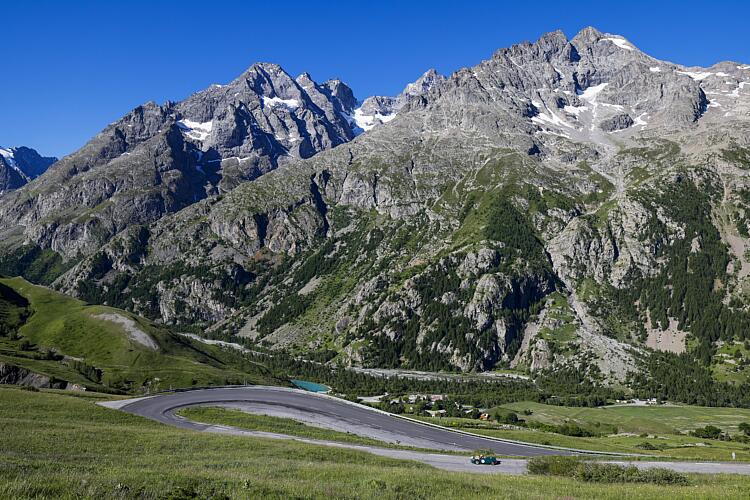
The highest pass we traversed was the Col de Lombarde, in Italy, at 2350 metres. Not only the highest but the steepest and the tightest, with the narrowest roads.
The descent was something else.
There was simply no way to stay off the brakes without the tachometer needle being in the red zone all the time, and this was the only time we had a mechanical problem.
Suddenly, coming into a tight curve, the brake pedal went straight to the floor.
I pumped it hard and got enough pressure to slow the car and downshifted through a couple more turns, very slowly, until we could pull off the road.
The brake fluid had got so hot it had boiled, so there were now air bubbles in it.
RallyStory’s mechanics were there in 10 minutes, purged the brake lines on the spot, and we were back on the road…barely an incursion into the cocktail hour at the finish in Cannes.
If it is not obvious, this driving was really fun. All the thrills of a roller coaster, but you control it by applying concentration, boldness, and skill yourself.
The scenery, when you can look at it, is breathtaking.
It’s probably best not to look down, as the passenger, while the driver takes some of these turns at breakneck speed, the tires on the edge of screaming. (As the driver, you have no choice!)
“On se régale!” was the constant refrain from the many French drivers, “We are having a blast!” We certainly were.
The driving was hard work but supremely satisfying and exhilarating. The sense that you are getting better and better at pushing the car in the most balanced and fastest possible way through the hairpin switchbacks is thrilling.
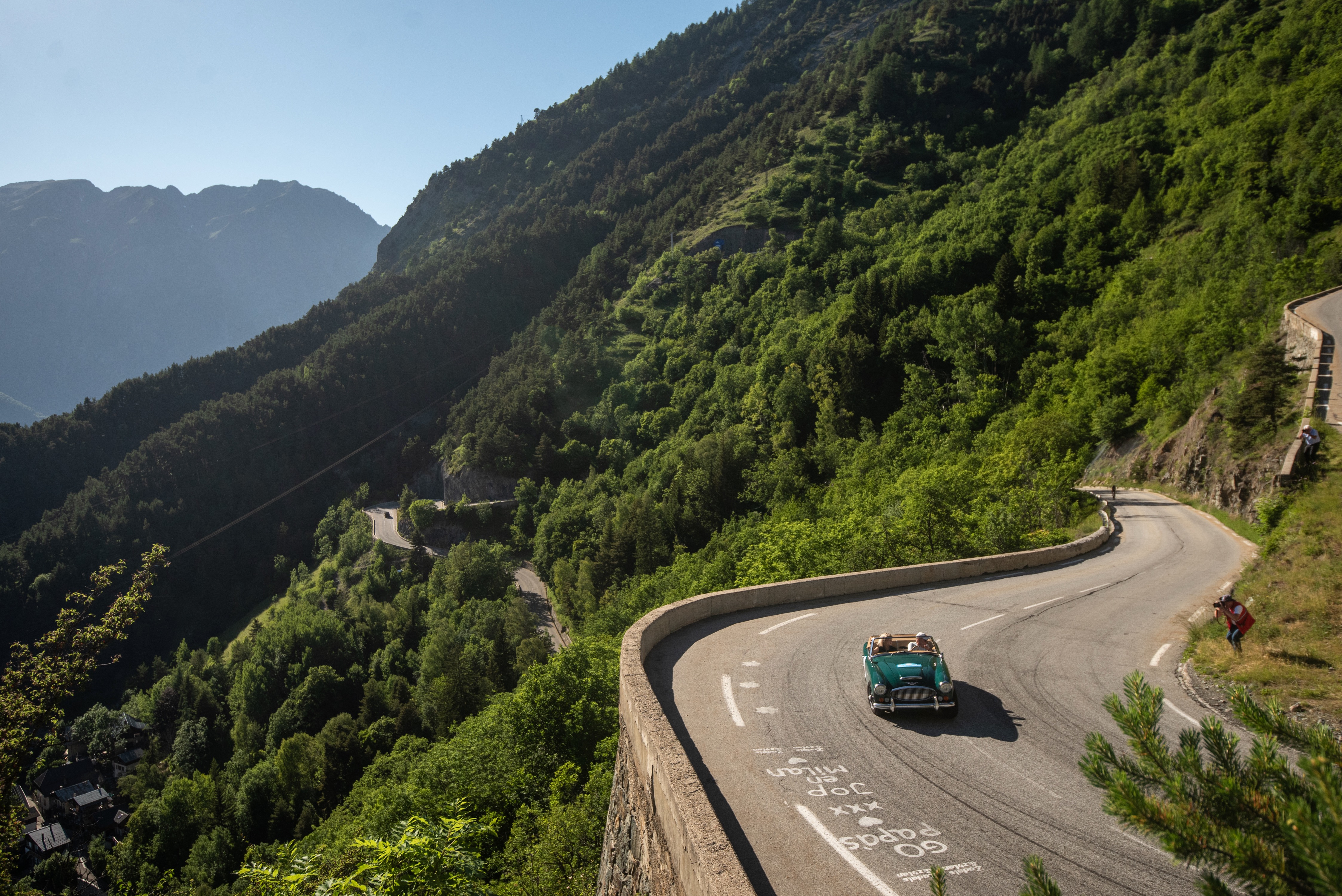
Watching my daughter develop a strong connection to the car, really driving it through the challenging corners instead of just negotiating them, and even getting into duels with experienced men driving cars with rally pedigrees put a smile on my face I won’t soon forget.
Huge kudos to the Healey by the way. Great road holding and tolerance for driver error, long hours at high revs, she just seemed happier the harder she was driven, more solid and secure the faster she was pushed.
And if that weren’t enough, Rallystory organizes everything.
First class accommodation, our first night in Megève, a high end historic French Alpine resort, the next in Alpe d’Huez, higher, more modern, very luxurious hotel.
Wonderful meals and refreshment breaks all along the route, a beautifully served dinner on the beach in Cannes after the arrival, and the last night in the Majestic, a historic luxury hotel right on the promenade of the Cannes Croisette, with all the elegance the French Riviera can muster.
This is by no means an inexpensive experience, but in Europe, June is off-season, and with the buying power of 300 people plus the rally organizers dining and staying in hotels that otherwise would be largely empty, Rallystory is able to offer exceptionally good value.
The organization and support are outstanding.
Rallystory events are carbon neutral. For my part, I calculated the emissions of shipping the car, last minute by air, which was clearly much worse than would have been the case by sea, as equivalent, according to the car’s weight, of 8 economy class tickets.
I offset that, the driving to and from the rally, and my flights, for about $400 Canadian, with MyClimate.org.
As a general rule, I think it is up to our governments to use regulation and taxes to reduce fossil fuel consumption and drive carbon capture to protect our environment. However, this event was a purely optional activity which added to our carbon footprint solely for our entertainment and amusement, so we felt we had an obligation to do what we could to make it as harmless as possible.
Based on our experience, anyone who enjoys speed, likes to shift their own gears, understands the fundamental point that a turning car is more stable accelerating, and is willing to get a little outside of their comfort zone, can enjoy participating in these rally revivals.
As the Alpine Rally (Coupe des Alpes) is one of the most storied, it is an experience you won’t forget. It is also possible to rent vintage sports cars to participate.
These “rally experiences” (“Rallyes Loisirs” in French) are not the danger-filled gruelling events they were in their original form. They are still tough, require endurance, and put you to the test, and of course they are not without some risk.
But if you have a vintage sports car (20 years old or more) and you want to legally drive it to its limits and the limits of your own skill, I promise you a once-in-a-lifetime memorable experience.